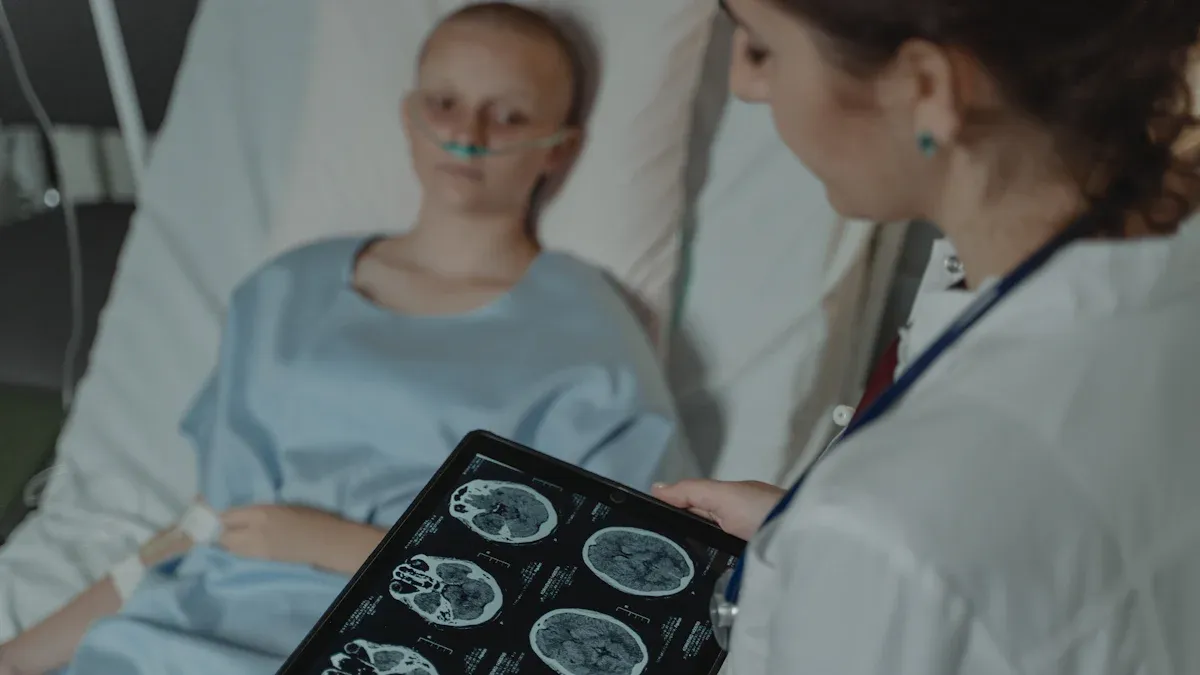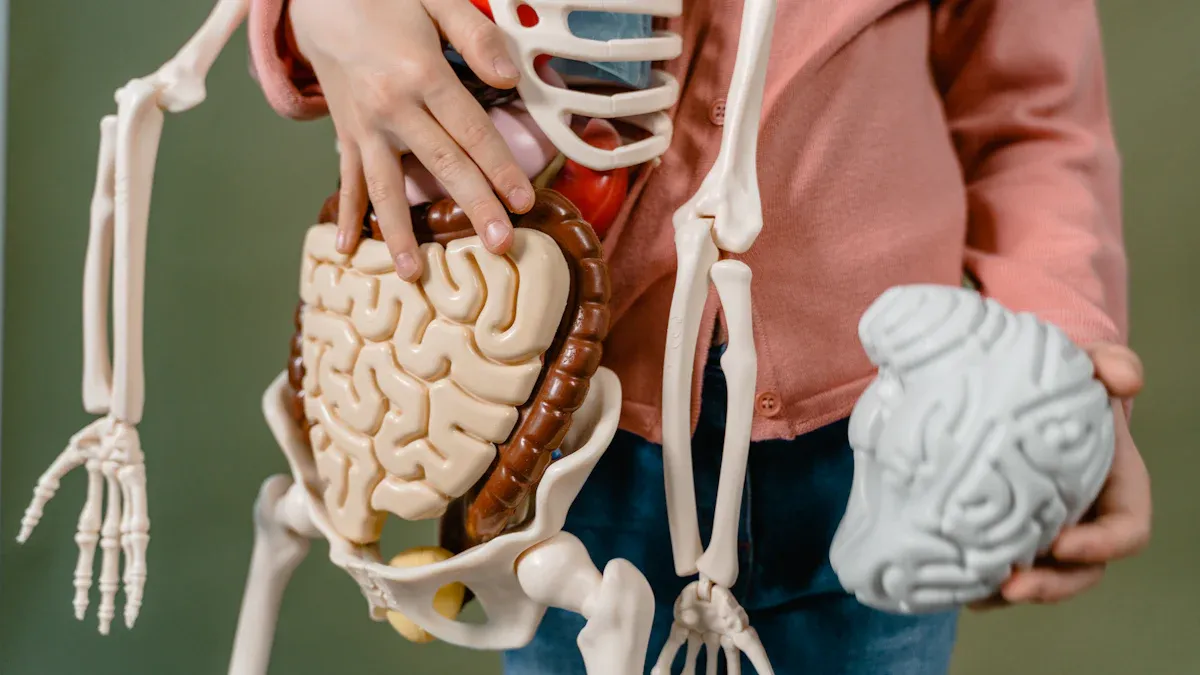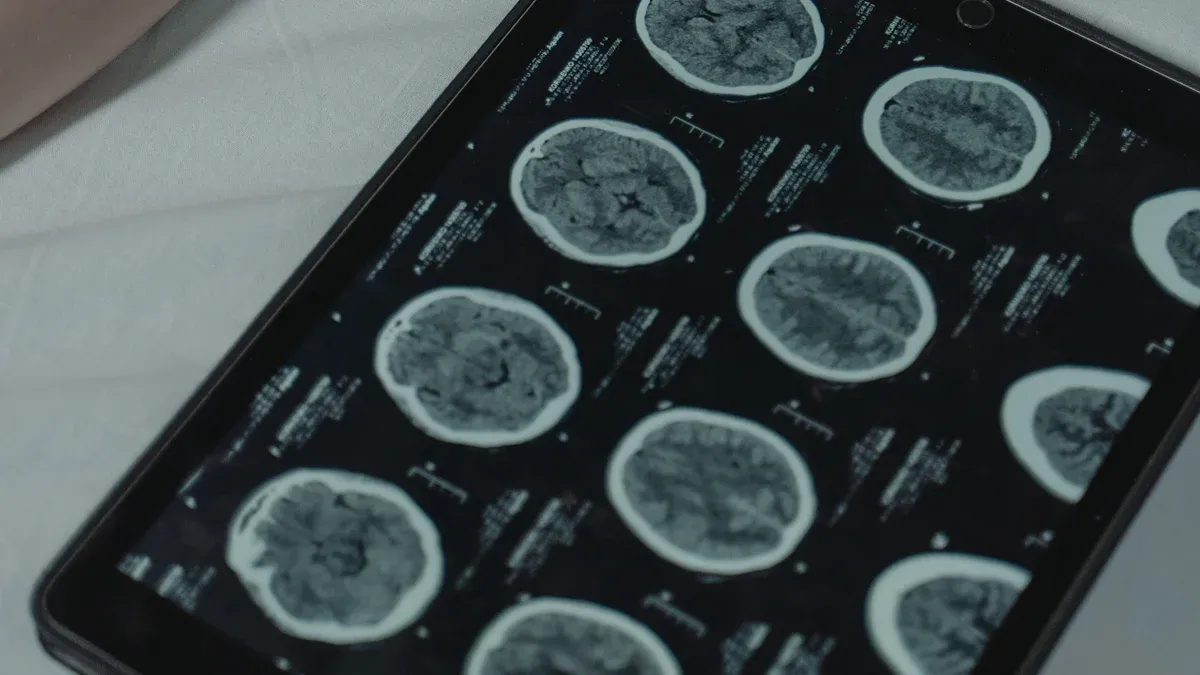Glioblastoma Explained: Understanding Its Key Traits

Glioblastoma is one of the most aggressive forms of brain cancer. It develops in astrocytes, which are star-shaped cells that support nerve cells in your brain. Doctors classify it as a grade IV brain tumor, the most severe type. This tumor grows quickly and resists many treatments, making it especially challenging to manage.
Glioblastomas make up about 14% of all primary brain tumors.
They account for nearly 48% of malignant brain and central nervous system tumors.
Despite treatment, the average survival time is only 12 to 15 months. Fewer than 7% of patients survive beyond five years.
Key Takeaways
Glioblastoma is a fast-growing brain cancer. Most patients live 12 to 15 months, even with treatment.
Surgery, radiation, and chemotherapy are important to treat glioblastoma.
Learning about the tumor's molecular details helps doctors choose better treatments.
Finding it early and seeing a brain surgeon quickly can improve chances of success.
New treatments, like immunotherapy, give hope for better ways to manage glioblastoma.
Characteristics of Glioblastoma

Aggressive Nature and Growth Patterns
Glioblastoma stands out as one of the most aggressive brain tumors. It grows rapidly and invades nearby brain tissue, making it difficult to treat. Unlike other brain tumors, glioblastoma spreads along white matter fibers and blood vessels. These structures act as pathways, allowing tumor cells to migrate and expand. This unique growth pattern complicates treatment and impacts patient outcomes.
The tumor's fast growth rate often leads to a late diagnosis. By the time symptoms appear, glioblastoma has usually spread extensively. Its infiltrative nature makes complete surgical removal nearly impossible, requiring a combination of therapies to manage the disease.
Common Locations in the Brain
Glioblastoma can develop in various parts of the brain, but some areas are more commonly affected than others. The table below highlights these locations and their functions:
Brain Area | Commonality | Functionality Description |
|---|---|---|
Frontal Lobe | Most Common | Speech, movement, behavior, memory |
Temporal Lobe | Common | Memory creation, language processing, sensory input |
Parietal Lobe | Less Common | Sensory perception, spatial awareness |
Occipital Lobe | Less Common | Visual processing |
Cerebellum | Least Common | Coordination, balance |
The tumor's location significantly influences treatment options. Tumors in critical areas, like the frontal or temporal lobes, may limit surgical resection due to the risk of damaging essential brain functions.
Cellular and Genetic Traits
Glioblastoma exhibits distinct cellular and genetic abnormalities. Primary glioblastomas often show:
Overexpression of the epidermal growth factor receptor (EGFR).
Mutations in the phosphate and tensin homologue (PTEN) gene.
Loss of chromosome 10q.
Secondary glioblastomas, which develop from lower-grade tumors, frequently have:
Isocitrate dehydrogenase 1 (IDH1) mutations.
p53 mutations.
Loss of chromosome 19q.
These genetic changes activate core signaling pathways, such as the tumor protein p53 pathway and the receptor tyrosine kinase pathway. Understanding these traits helps researchers develop targeted therapies to improve treatment outcomes.
Symptoms and Effects
Common Symptoms
Glioblastoma often causes a wide range of symptoms that can vary depending on the tumor's size and location. You might notice persistent headaches that worsen over time or experience seizures, which can take different forms. Memory problems and confusion are also common, making it harder to focus or recall information. Changes in personality, such as mood swings or irritability, may occur as well.
Other symptoms include muscle weakness, numbness, or tingling in certain areas of your body. You might feel unusually fatigued or have trouble with coordination, making everyday tasks more challenging. Speech, vision, and hearing problems can also develop, depending on which part of the brain is affected.
As the disease progresses, these symptoms often intensify. Headaches may become more severe, and seizures might happen more frequently. You could notice increased difficulty in speaking, concentrating, or responding to your surroundings. Over time, excessive sleepiness and withdrawal from social interactions may occur.
Impact on Brain Function and Overall Health
Glioblastoma significantly impacts your brain's ability to function. Around 75–80% of patients experience some level of cognitive impairment. For example, if the tumor affects the frontal lobe, you might struggle with decision-making or controlling your behavior. Tumors in areas like Broca's region can lead to expressive aphasia, making it hard to form words or sentences.
The tumor's rapid growth also causes neurological symptoms that extend beyond the brain. You might experience physical issues like incontinence or difficulty swallowing. Behavioral changes, such as irritability or withdrawal, can affect your relationships and daily life. Mood disorders, including anxiety and depression, are common after a diagnosis. These effects, combined with the tumor's physical symptoms, can significantly reduce your quality of life.
Causes and Risk Factors
Known Causes
Glioblastoma has several known causes, many of which are linked to rare genetic conditions. If you or someone in your family has a condition like Li-Fraumeni syndrome, neurofibromatosis, or Turcot syndrome, the risk of developing this tumor increases. Other conditions, such as Lynch syndrome and constitutional mismatch repair deficiency syndrome, also raise the likelihood of glioblastoma.
Exposure to ionizing radiation is another significant cause. This type of radiation can come from previous radiation therapy used to treat other cancers. If you've undergone such treatments, your brain tissue may have been exposed to harmful radiation, increasing your risk.
Genetic and Environmental Risk Factors
Genetic mutations play a key role in glioblastoma development. Changes in specific genes, such as TP53 or EGFR, can disrupt normal cell growth and lead to tumor formation. If you have a family history of brain tumors, your genetic makeup might make you more susceptible.
Environmental factors also contribute to glioblastoma risk, though the evidence varies. Ionizing radiation is one of the few well-established environmental risk factors. For example, exposure to high levels of radiation, whether from medical treatments or environmental sources, can increase your chances of developing this tumor. Other exposures, like pesticides or vinyl chloride, have shown weak associations with glioblastoma.
Nonionizing radiation, such as that from cell phones, has not been proven to cause glioblastoma. Similarly, studies on outdoor pollution have produced inconsistent results. While these factors may not pose a significant risk, understanding your environment and minimizing exposure to harmful substances can still benefit your overall health.
Diagnosis and Staging
Diagnostic Methods
Diagnosing glioblastoma involves a combination of imaging techniques and tissue analysis. Magnetic resonance imaging (MRI) is the most effective tool for identifying this tumor. It provides detailed images of the brain, helping doctors understand the tumor's size and location. Advanced MRI techniques, like MRI spectroscopy (MRS), reveal the tumor's chemical composition. Functional MRI (fMRI) maps brain regions affected by the tumor, which is critical for planning surgery. Diffusion-weighted imaging and MRI radiomics further enhance diagnostic accuracy.
Computed tomography (CT) scans may also be used, but MRI is preferred due to its superior ability to detect tumor infiltration. In some cases, advanced brain tumor imaging (ABTI) techniques can provide additional insights.
A biopsy is essential for confirming a glioblastoma diagnosis. During this procedure, doctors collect a tissue sample to examine the tumor's histology and molecular biomarkers. While imaging tests suggest the presence of a tumor, only a biopsy can provide a definitive diagnosis. This step ensures that treatment plans are tailored to the tumor's specific characteristics.
Staging and Prognosis
Glioblastoma does not follow a traditional staging system like other cancers. Instead, doctors assess factors such as the tumor's size, location, and molecular profile to determine its severity. Prognosis depends on several key factors:
Age: Younger patients, especially those under 55, tend to have better outcomes.
Gender: Women often experience slightly improved survival rates compared to men.
Extent of surgical resection: Removing as much of the tumor as possible improves survival.
Molecular characteristics: Tumors with IDH mutations or MGMT methylation respond better to treatment.
Overall health: Patients in good health at diagnosis typically fare better.
On average, patients receiving treatment live 12–15 months, while those without treatment survive about four months. Survival rates also vary by age group. For example, children have a 19.5% five-year survival rate, while adults over 40 have only 5.6%. These statistics highlight the aggressive nature of glioblastoma and the importance of early intervention.
Treatment Options

Standard Treatments
Treating glioblastoma requires a multi-step approach to manage its aggressive nature. The first step usually involves surgery to remove as much of the tumor as possible while preserving healthy brain tissue. This procedure, known as debulking, aims to reduce the tumor's size and relieve pressure on the brain.
After surgery, radiation therapy targets any remaining cancer cells. This treatment uses high-energy rays to destroy tumor cells and prevent further growth. Chemotherapy, often with the drug temozolomide, is administered alongside radiation therapy and continues afterward. Temozolomide works by interfering with the tumor's ability to replicate its DNA, slowing its progression.
For elderly patients or those with limited self-care abilities, doctors may recommend a modified treatment plan. This approach balances effectiveness with the patient’s overall health and quality of life.
Emerging Therapies and Research
Researchers are exploring innovative therapies to improve outcomes for glioblastoma patients. One promising approach is proton beam therapy, an advanced form of radiation that delivers precise doses to the tumor while sparing healthy tissue. Clinical trials have shown that this method can extend survival times, especially for patients with favorable tumor genetics.
Immunotherapy is another area of active research. Scientists are developing treatments like dendritic cell vaccines, which train your immune system to recognize and attack glioblastoma cells. CAR T-cell therapy, which modifies your T cells to target tumor-specific proteins, is also being tested.
Additionally, tumor treating fields (TTFs) offer a non-invasive option. This therapy involves wearing a device that emits low-intensity electric fields to disrupt tumor cell division. Early studies suggest that TTFs can slow tumor growth when combined with standard treatments.
Recent breakthroughs include ultrasound technology to enhance drug delivery across the blood-brain barrier. This method improves the effectiveness of chemotherapy and immunotherapy, offering new hope for patients.
Glioblastoma remains one of the most aggressive and challenging brain cancers. Its defining traits include rapid growth, resistance to treatment, and a poor prognosis. Key takeaways include:
The median survival time is around 15 months, even with treatment.
Multimodal therapy, combining surgery, radiation, and chemotherapy, is essential.
Molecular profiling plays a critical role in tailoring treatments.
Early palliative care improves symptom management and quality of life.
Early detection is vital for improving outcomes. You benefit from quicker surgical intervention and better prognosis when diagnosis and surgery occur promptly. Immediate referral to a neurosurgeon can make a significant difference.
Ongoing research offers hope for the future. Scientists are developing advanced therapies like immunotherapy and targeted treatments. New technologies for molecular characterization aim to enhance diagnosis and treatment precision. These efforts could transform glioblastoma care and improve survival rates.
FAQ
What is the difference between primary and secondary glioblastoma?
Primary glioblastoma develops rapidly without any prior tumor history. Secondary glioblastoma evolves from lower-grade brain tumors over time. Both types share aggressive traits, but secondary glioblastomas often occur in younger patients and have distinct genetic mutations, such as IDH1 mutations.
Can glioblastoma be cured?
Currently, glioblastoma cannot be cured. Treatments aim to slow its growth and manage symptoms. Researchers are exploring new therapies, like immunotherapy and targeted treatments, to improve outcomes. Early diagnosis and a multimodal treatment approach can help extend survival and enhance quality of life.
How does glioblastoma affect daily life?
Glioblastoma impacts your memory, speech, and coordination. You might experience fatigue, mood changes, or difficulty performing everyday tasks. These effects depend on the tumor's location and size. Supportive care, including physical therapy and counseling, can help you manage these challenges.
Is glioblastoma hereditary?
Most glioblastomas are not hereditary. However, rare genetic conditions, like Li-Fraumeni syndrome or neurofibromatosis, can increase your risk. If you have a family history of brain tumors, consider genetic counseling to assess your risk and explore preventive measures.
What should you do if you suspect glioblastoma symptoms?
If you notice persistent headaches, seizures, or memory problems, consult a doctor immediately. Early imaging tests, like MRI, can detect abnormalities. Prompt diagnosis allows for quicker treatment, which can improve your prognosis and quality of life.
---
ℹ️ Explore more: Read our Comprehensive Guide to All Known Cancer Types for symptoms, causes, and treatments.
See Also
Essential Insights About Ganglioneuroma You Need To Understand
Key Features And Insights Into Craniopharyngioma Explained
An Overview Of Astrocytoma And Its Various Forms
